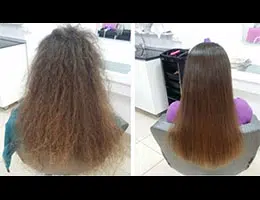 Many times we find the word keratin on the packaging of various products or in the media. However, the term is not part of the dictionary of the Royal Spanish Academy ( RAE ).
Many times we find the word keratin on the packaging of various products or in the media. However, the term is not part of the dictionary of the Royal Spanish Academy ( RAE ).
The correct concept in our language is keratin , derived from the Greek keratínē . Keratin, therefore, is an erroneous word that is made with a misspelling.
Keratin, in short, is a protein that stands out for its high sulfur level . It is an essential component of the superficial layers of the epidermis of vertebrate animals and of the parts derived from these layers, such as hair , nails , horns and feathers .
Like all proteins , keratin is a macromolecule (a molecule characterized by its large size) that is made up of linear chains of amino acids. In the case of alpha-keratin , its amino acid chains have cysteine monomers that produce disulfide bridges. Beta-keratin , on the other hand, has very little cysteine or does not have this substance at all.
Thanks to keratin, various structures of the body acquire their hardness and resistance. Keratin, for example, is a very important element of hair : in fact, each hair is made up mainly of keratin.
Therefore, when hair is damaged for multiple reasons (such as chlorine in a swimming pool, chemicals in a shampoo, or heat from an iron), it is possible to perform a keratin treatment to restore its strength.
Keratin treatment is ideal for styling hair more easily and leaving frizz behind. For those people who want to have smooth, shiny and easy-to-comb hair, the use of this protein is highly recommended. Hair repair and nutrition are tasks that many people overlook, but especially with the arrival of old age they come in handy.
Through a keratin treatment we can repair the hair fibers, nourish each hair from the root to the tip and give it a silky appearance, while protecting it from external agents that threaten its condition, such as chemicals and irons to smooth it.
Needless to say, keratin treatment also has disadvantages, as with any other treatment. For this reason, it is advisable to know them before venturing to apply it to know if its benefits are worth it. Let's see a list of its disadvantages below:
 * if it contains formaldehyde, thanks to which permanent straightening is achieved, it is important not to inhale it or allow it to come into contact with our hands, since it is a toxic product and contains carcinogenic substances;
* if it contains formaldehyde, thanks to which permanent straightening is achieved, it is important not to inhale it or allow it to come into contact with our hands, since it is a toxic product and contains carcinogenic substances;
* The price of each application is usually high, and the total duration of its effect can be three to six months. This represents a high investment per year for those who want to do it without interruptions, although it is not advisable to prevent the hair from resting from these products;
* Keratin treatment is not suitable for all hair types. For example, considerable results are not seen in fine hair with little volume, and it could even break. Furthermore, during the first days after application it is not recommended to collect, dye or bleach your hair;
* some people are prone to allergic reactions from scalp and eye contact with keratin. To minimize this risk, it is recommended that it be applied by an experienced professional.
Because certain keratins appear in higher than normal amounts in patients with certain types of cancer , measuring the level of specific keratins in the bloodstream contributes to the planning and evaluation of treatment against oncological diseases.
